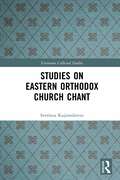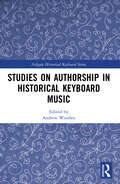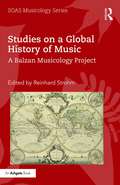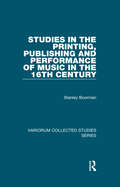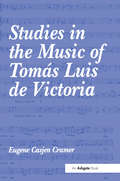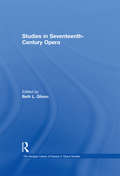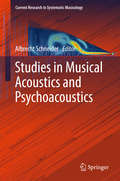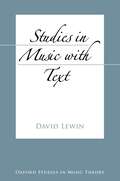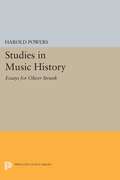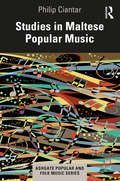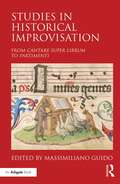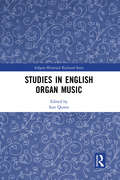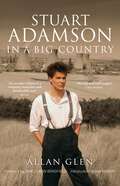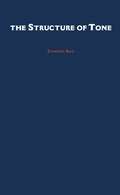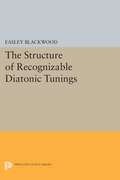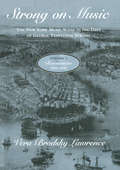- Table View
- List View
Studies on Eastern Orthodox Church Chant (Variorum Collected Studies)
by Svetlana KujumdzievaThis book focuses on the compilation of the different practices of Eastern Orthodox Chant, looking at the subject through various languages, practices, and liturgical books and letters. The subject of this book is also analysed through newly found, unique material, to provide the entire history of Eastern Orthodox Chant, from the ninth to the nineteenth centuries and approached through a number of different disciplines. The book consists of sixteen topics, grouped in four parts: Studies on Genre, Studies on Liturgical Books, Studies on Distinguished Men of Letters, and Studies on Bulgarian Orthodox Church Chant. The aim of the book is to present the Eastern chant as a phase in the evolution of Mediterranean art, which is the cradle of Graeco-Roman heritage. This complex study brings in a variety of sources to show the purpose of Eastern Orthodox Chant as strengthening the Christian faith during the Middle Ages and the revival of Balkan nationalism in the nineteenth century. This book will appeal to students and scholars alike, interested in liturgical musical books, liturgy, and chant repertory. Likewise, it will be of interest to those engaged in medieval and early modern history, music, and culture.
Studies on Authorship in Historical Keyboard Music (Ashgate Historical Keyboard Series)
by Andrew WoolleyAuthorship is a pertinent issue for historical musicology and musicians more widely, and some controversies concerned with major figures have even reached wider consciousness. Scholars have clarified some of the issues at stake in recent decades, such as the places of borrowing and arranging in the creative process and the wider cultural significance of these practices. The discovery of new sources and methodologies has also opened up opportunities for reassessing specific authorship problems. Drawing upon this wider musicological literature as well as insights from other disciplines, such as intellectual history and book history, this book aims to build on what has already been achieved by focussing on keyboard music. The nine chapters cover case studies of authorship problems, the socioeconomic conditions of music publishing, the contributions of composers, arrangers, copyists and music publishers in creating notated keyboard compositions, the functions of attribution and ascription, and how the contexts in which notated pieces were used affected concepts of authorship at different times and places.
Studies on Authorship in Historical Keyboard Music (Ashgate Historical Keyboard Series)
by Andrew WoolleyAuthorship is a pertinent issue for historical musicology and musicians more widely, and some controversies concerned with major figures have even reached wider consciousness. Scholars have clarified some of the issues at stake in recent decades, such as the places of borrowing and arranging in the creative process and the wider cultural significance of these practices. The discovery of new sources and methodologies has also opened up opportunities for reassessing specific authorship problems. Drawing upon this wider musicological literature as well as insights from other disciplines, such as intellectual history and book history, this book aims to build on what has already been achieved by focussing on keyboard music. The nine chapters cover case studies of authorship problems, the socioeconomic conditions of music publishing, the contributions of composers, arrangers, copyists and music publishers in creating notated keyboard compositions, the functions of attribution and ascription, and how the contexts in which notated pieces were used affected concepts of authorship at different times and places.
Studies on a Global History of Music: A Balzan Musicology Project (SOAS Studies in Music Series)
by Reinhard StrohmThe idea of a global history of music may be traced back to the Enlightenment, and today, the question of a conceptual framework for a history of music that pays due attention to global relationships in music is often raised. But how might a historical interpretation of those relationships proceed? How should it position, or justify, itself? What would 'Western music' look like in an account of music history that aspires to be truly global? The studies presented in this volume aim to promote post-European historical thinking. They are based on the idea that a global history of music cannot be one single, hegemonic history. They rather explore the paradigms and terminologies that might describe a history of many different voices. The chapters address historical practices and interpretations of music in different parts of the world, from Japan to Argentina and from Mexico to India. Many of these narratives are about relations between these cultures and the Western tradition; several also consider socio-political and historical circumstances that have affected music in the various regions. The book addresses aspects that Western musical historiography has tended to neglect even when looking at its own culture: performance, dance, nostalgia, topicality, enlightenment, the relationships between traditional, classical, and pop musics, and the regards croisés between European, Asian, or Latin American interpretations of each other’s musical traditions. These studies have been derived from the Balzan Musicology Project Towards a Global History of Music (2013–2016), which was funded by the International Balzan Foundation through the award of the Balzan Prize in Musicology to the editor, and designed by music historians and ethnomusicologists together. A global history of music may never be written in its entirety, but will rather be realised through interaction, practice, and discussion, in all parts of the world.
Studies on a Global History of Music: A Balzan Musicology Project (SOAS Studies in Music Series)
by Reinhard StrohmThe idea of a global history of music may be traced back to the Enlightenment, and today, the question of a conceptual framework for a history of music that pays due attention to global relationships in music is often raised. But how might a historical interpretation of those relationships proceed? How should it position, or justify, itself? What would 'Western music' look like in an account of music history that aspires to be truly global? The studies presented in this volume aim to promote post-European historical thinking. They are based on the idea that a global history of music cannot be one single, hegemonic history. They rather explore the paradigms and terminologies that might describe a history of many different voices. The chapters address historical practices and interpretations of music in different parts of the world, from Japan to Argentina and from Mexico to India. Many of these narratives are about relations between these cultures and the Western tradition; several also consider socio-political and historical circumstances that have affected music in the various regions. The book addresses aspects that Western musical historiography has tended to neglect even when looking at its own culture: performance, dance, nostalgia, topicality, enlightenment, the relationships between traditional, classical, and pop musics, and the regards croisés between European, Asian, or Latin American interpretations of each other’s musical traditions. These studies have been derived from the Balzan Musicology Project Towards a Global History of Music (2013–2016), which was funded by the International Balzan Foundation through the award of the Balzan Prize in Musicology to the editor, and designed by music historians and ethnomusicologists together. A global history of music may never be written in its entirety, but will rather be realised through interaction, practice, and discussion, in all parts of the world.
Studies in the Printing, Publishing and Performance of Music in the 16th Century
by Stanley BoormanThe emergence of music printing and publishing in the early 16th century radically changed how music was circulated, and how the musical source (printed or manuscript) was perceived, and used in performance. This series of close studies of the structure and content of 16th-century and early 17th-century editions (and some manuscripts) of music draws conclusions in a number of areas - printing techniques for music; the habits of different type-setters and scribes, and their view of performing practice; publishers' approaches to the musical market and its abilities and interests; apparent changes of plan in preparing editions; questions of authorship; evidence in editions and manuscripts for interpreting different levels of notation; ways in which scribes could influence performers' decisions, and others by which composers could exploit unusual sonorities.
Studies in the Printing, Publishing and Performance of Music in the 16th Century
by Stanley BoormanThe emergence of music printing and publishing in the early 16th century radically changed how music was circulated, and how the musical source (printed or manuscript) was perceived, and used in performance. This series of close studies of the structure and content of 16th-century and early 17th-century editions (and some manuscripts) of music draws conclusions in a number of areas - printing techniques for music; the habits of different type-setters and scribes, and their view of performing practice; publishers' approaches to the musical market and its abilities and interests; apparent changes of plan in preparing editions; questions of authorship; evidence in editions and manuscripts for interpreting different levels of notation; ways in which scribes could influence performers' decisions, and others by which composers could exploit unusual sonorities.
Studies in the Music of Tomás Luis de Victoria
by EugeneCasjen CramerRepresenting nearly thirty years of research by one of the leading scholars in the field, this series of in-depth studies examines selected aspects of the music of the great Spanish composer in the late Renaissance, Tom Luis de Victoria. Presenting new insights into both the musical style and language and the compositional procedure of this contemporary of Palestrina, Lasso and Byrd, Eugene Cramer illuminates the extent to which Victoria's compositions are musically related. The book reveals that the falsobordone or fabord layed a much larger role in Victoria's music than has previously been thought. Cramer also demonstrates that Victoria's parody or imitation technique, especially in respect to his Masses of 1592, extended the parameters that are generally thought to be characteristic of works of this type. Of special interest is the discussion of thirty-eight works, including thirty-four psalm settings that are attributed to Victoria in extant manuscript sources. Extensively illustrated with over 130 musical examples, these studies will not only interest the serious student of sacred music, but also the performer, both the singer and the conductor alike.
Studies in the Music of Tomás Luis de Victoria
by EugeneCasjen CramerRepresenting nearly thirty years of research by one of the leading scholars in the field, this series of in-depth studies examines selected aspects of the music of the great Spanish composer in the late Renaissance, Tom Luis de Victoria. Presenting new insights into both the musical style and language and the compositional procedure of this contemporary of Palestrina, Lasso and Byrd, Eugene Cramer illuminates the extent to which Victoria's compositions are musically related. The book reveals that the falsobordone or fabord layed a much larger role in Victoria's music than has previously been thought. Cramer also demonstrates that Victoria's parody or imitation technique, especially in respect to his Masses of 1592, extended the parameters that are generally thought to be characteristic of works of this type. Of special interest is the discussion of thirty-eight works, including thirty-four psalm settings that are attributed to Victoria in extant manuscript sources. Extensively illustrated with over 130 musical examples, these studies will not only interest the serious student of sacred music, but also the performer, both the singer and the conductor alike.
Studies in Seventeenth-Century Opera
by BethL. GlixonThe past four decades have seen an explosion in research regarding seventeenth-century opera. In addition to investigations of extant scores and librettos, scholars have dealt with the associated areas of dance and scenery, as well as newer disciplines such as studies of patronage, gender, and semiotics. While most of the essays in the volume pertain to Italian opera, others concern opera production in France, England, Spain and the Germanic countries.
Studies in Seventeenth-Century Opera
by BethL. GlixonThe past four decades have seen an explosion in research regarding seventeenth-century opera. In addition to investigations of extant scores and librettos, scholars have dealt with the associated areas of dance and scenery, as well as newer disciplines such as studies of patronage, gender, and semiotics. While most of the essays in the volume pertain to Italian opera, others concern opera production in France, England, Spain and the Germanic countries.
Studies in Musical Acoustics and Psychoacoustics (Current Research in Systematic Musicology #4)
by Albrecht SchneiderThis book comprises twelve articles which cover a range of topics from musical instrument acoustics to issues in psychoacoustics and sound perception as well as neuromusicology. In addition to experimental methods and data acquisition, modeling (such as FEM or wave field synthesis) and numerical simulation plays a central role in studies addressing sound production in musical instruments as well as interaction of radiated sound with the environment. Some of the studies have a focus on psychoacoustic aspects in regard to virtual pitch and timbre as well as apparent source width (for techniques such as stereo or ambisonics) in music production. Since musical acoustics imply subjects playing instruments or singing in order to produce sound according to musical structures, this area is also covered including a study that presents an artificial intelligent agent capable to interact with a real ('analog') player in musical genres such as traditional and free jazz.
Studies in Music with Text (Oxford Studies in Music Theory)
by David LewinThroughout his career, David Lewin labored to make even the most abstract theory speak to the experience of the ordinary listener. This book combines many of Lewin's classic articles on song and opera with newly drafted chapters on songs of Brahms, Robert Schumann, Clara Schumann, and Milton Babbitt. Bound together by Lewin's cogent insight, the resulting collection constitutes a major statement concerning the methodological problems associated with interpretation of texted music.
Studies in Music with Text (Oxford Studies in Music Theory)
by David LewinThroughout his career, David Lewin labored to make even the most abstract theory speak to the experience of the ordinary listener. This book combines many of Lewin's classic articles on song and opera with newly drafted chapters on songs of Brahms, Robert Schumann, Clara Schumann, and Milton Babbitt. Bound together by Lewin's cogent insight, the resulting collection constitutes a major statement concerning the methodological problems associated with interpretation of texted music.
Studies in Music History: Essays for Oliver Strunk
by Harold PowersA wide variety of essays by colleagues and former students reflect Professor Strunk's particular role as music historian, teacher, and a pre-eminent musicologist. Donald Grout provides the introduction and outlines the problems confronting musicology today. Other essays are devoted to early Christian music, Renaissance music, early Italian opera; Arthur Mendel writes on ambiguities of the munsural system, Edward Lowinsky on Willaert’s "Chromatic Duo," Joseph Kerman on Verdi, and Elliot Forbes on Beethoven.Originally published in 1958.The Princeton Legacy Library uses the latest print-on-demand technology to again make available previously out-of-print books from the distinguished backlist of Princeton University Press. These editions preserve the original texts of these important books while presenting them in durable paperback and hardcover editions. The goal of the Princeton Legacy Library is to vastly increase access to the rich scholarly heritage found in the thousands of books published by Princeton University Press since its founding in 1905.
Studies in Maltese Popular Music (Ashgate Popular and Folk Music Series)
by Philip CiantarThis book examines the diverse facets of popular music in Malta, paying special attention to għana (Malta’s folk song), the wind band tradition, and modern popular music. Ciantar provides intriguing discussions and examples of how popular music on this small Mediterranean island country interacts with other aspects of the island’s life and culture such as language, religion, history, customs, and politics. Through a series of ethnographic vignettes, the book explores the music as it takes place in bars, at festivals, and during village celebrations, and considers how it is talked about in the local press, at group gatherings, and on social media. The ethnography adopted here is that of a native musician and ethnomusicologist and therefore marries the author’s memories with ongoing observations and their evaluation.
Studies in Maltese Popular Music (Ashgate Popular and Folk Music Series)
by Philip CiantarThis book examines the diverse facets of popular music in Malta, paying special attention to għana (Malta’s folk song), the wind band tradition, and modern popular music. Ciantar provides intriguing discussions and examples of how popular music on this small Mediterranean island country interacts with other aspects of the island’s life and culture such as language, religion, history, customs, and politics. Through a series of ethnographic vignettes, the book explores the music as it takes place in bars, at festivals, and during village celebrations, and considers how it is talked about in the local press, at group gatherings, and on social media. The ethnography adopted here is that of a native musician and ethnomusicologist and therefore marries the author’s memories with ongoing observations and their evaluation.
Studies in Historical Improvisation: From Cantare super Librum to Partimenti
by Massimiliano GuidoIn recent years, scholars and musicians have become increasingly interested in the revival of musical improvisation as it was known in the Renaissance and Baroque periods. This historically informed practice is now supplanting the late Romantic view of improvised music as a rhapsodic endeavour—a musical blossoming out of the capricious genius of the player—that dominated throughout the twentieth century. In the Renaissance and Baroque eras, composing in the mind (alla mente) had an important didactic function. For several categories of musicians, the teaching of counterpoint happened almost entirely through practice on their own instruments. This volume offers the first systematic exploration of the close relationship among improvisation, music theory, and practical musicianship from late Renaissance into the Baroque era. It is not a historical survey per se, but rather aims to re-establish the importance of such a combination as a pedagogical tool for a better understanding of the musical idioms of these periods. The authors are concerned with the transferral of historical practices to the modern classroom, discussing new ways of revitalising the study and appreciation of early music. The relevance and utility of such an improvisation-based approach also changes our understanding of the balance between theoretical and practical sources in the primary literature, as well as the concept of music theory itself. Alongside a word-centred theoretical tradition, in which rules are described in verbiage and enriched by musical examples, we are rediscovering the importance of a music-centred tradition, especially in Spain and Italy, where the music stands alone and the learner must distil the rules by learning and playing the music. Throughout its various sections, the volume explores the path of improvisation from theory to practice and back again.
Studies in Historical Improvisation: From Cantare super Librum to Partimenti
by Massimiliano GuidoIn recent years, scholars and musicians have become increasingly interested in the revival of musical improvisation as it was known in the Renaissance and Baroque periods. This historically informed practice is now supplanting the late Romantic view of improvised music as a rhapsodic endeavour—a musical blossoming out of the capricious genius of the player—that dominated throughout the twentieth century. In the Renaissance and Baroque eras, composing in the mind (alla mente) had an important didactic function. For several categories of musicians, the teaching of counterpoint happened almost entirely through practice on their own instruments. This volume offers the first systematic exploration of the close relationship among improvisation, music theory, and practical musicianship from late Renaissance into the Baroque era. It is not a historical survey per se, but rather aims to re-establish the importance of such a combination as a pedagogical tool for a better understanding of the musical idioms of these periods. The authors are concerned with the transferral of historical practices to the modern classroom, discussing new ways of revitalising the study and appreciation of early music. The relevance and utility of such an improvisation-based approach also changes our understanding of the balance between theoretical and practical sources in the primary literature, as well as the concept of music theory itself. Alongside a word-centred theoretical tradition, in which rules are described in verbiage and enriched by musical examples, we are rediscovering the importance of a music-centred tradition, especially in Spain and Italy, where the music stands alone and the learner must distil the rules by learning and playing the music. Throughout its various sections, the volume explores the path of improvisation from theory to practice and back again.
Studies in English Organ Music (Ashgate Historical Keyboard Series)
by Iain QuinnStudies in English Organ Music is a collection of essays by expert authors that examines key areas of the repertoire in the history of organ music in England. The essays on repertoire are placed alongside supporting studies in organ building and liturgical practice in order to provide a comprehensive contextualization. An analysis of the symbiotic relationship between the organ, liturgy, and composers reveals how the repertoire has been shaped by these complementary areas and developed through history. This volume is the first collection of specialist studies related to the field of English organ music.
Studies in English Organ Music (Ashgate Historical Keyboard Series)
by Iain QuinnStudies in English Organ Music is a collection of essays by expert authors that examines key areas of the repertoire in the history of organ music in England. The essays on repertoire are placed alongside supporting studies in organ building and liturgical practice in order to provide a comprehensive contextualization. An analysis of the symbiotic relationship between the organ, liturgy, and composers reveals how the repertoire has been shaped by these complementary areas and developed through history. This volume is the first collection of specialist studies related to the field of English organ music.
Stuart Adamson: In a Big Country
by Allan GlenThis is the book that fans of the Skids, Big Country and the Raphaels have been waiting for - a critical perspective not only of Adamson's music and its wider cultural influence, but also the excesses of fame and how the music business really works. Stuart Adamson: In a Big Country tells the story of how a teenager who was raised in a small Fife village released his first single at 19, wrote three Top 40 albums in the next three years and was written off as a has-been at 23, but then went on to form a new band and sell more than 10 million records worldwide, touring with the Rolling Stones and David Bowie. Although Stuart Adamson was one of the most respected and popular figures in the music industry, his personal life was complex - depression, alcoholism and estrangement - and ultimately tragic, ending with his suicide in a Hawaiian hotel in December 2001.
The Structure Of Tone
by Zhiming BaoThis book argues a fresh theory about the structure of tone. Bao investigates a wide range of tone sandhi data from various Chinese dialects and other Asian tone languages, providing empirical support for his proposal that tone is a formal entity which consists of register and contour. Bao establishes a clear typological distinction between register tone languages and contour tone languages whose contour tones have a more complex structure.
The Structure of Recognizable Diatonic Tunings
by Easley BlackwoodIn a comprehensive work with important implications for tuning theory and musicology, Easley Blackwood, a distinguished-composer, establishes a mathematical basis for the family of diatonic tunings generated by combinations of perfect fifths and octaves.Originally published in 1986.The Princeton Legacy Library uses the latest print-on-demand technology to again make available previously out-of-print books from the distinguished backlist of Princeton University Press. These editions preserve the original texts of these important books while presenting them in durable paperback and hardcover editions. The goal of the Princeton Legacy Library is to vastly increase access to the rich scholarly heritage found in the thousands of books published by Princeton University Press since its founding in 1905.
Strong on Music: The New York Music Scene in the Days of George Templeton Strong, Volume 1: Resonances, 1836-1849
by Vera Brodsky LawrenceIn Strong on Music Vera Brodsky Lawrence uses the diaries of lawyer and music lover George Templeton Strong as a jumping-off point from which to explore every aspect of New York City's musical life in the mid-nineteenth century. Formerly a concert pianist, Vera Brodsky Lawrence spent the last third of her life as a historian of American music (she died in 1996). She was editor of The Piano Works of Louis Moreau Gottschalk and The Complete Works of Scott Joplin. On Volume 1: "A marvelous book. There is nothing like it in the literature of American music."—Harold C. Schonberg, New York Times Book Review On Volume 2: "A monumental achievement."—Victor Fell Yellin, Opera Quarterly
